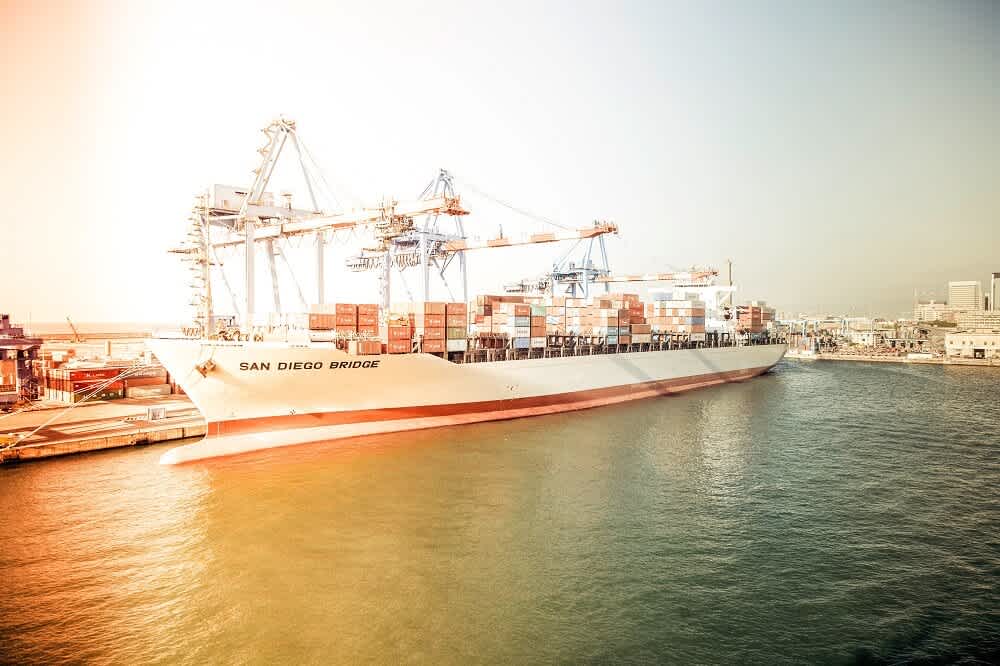
Last updated: July 08, 2022
Within the logistics industry, many different transportation methods are used to move products around the globe. One of the most common modes of transportation is within a break bulk cargo ship. Although this term is thrown around a lot in international shipping and transportation, many people mix up break bulk cargo shipping with other forms of cargo shipment.
Typically, the terms break bulk cargo, bulk cargo, and container ship cargo are used fairly interchangeably. However, each of these terms has a different meaning, and knowing what all of them involves is vital to understanding this industry. To help you get up to speed, this article will go through everything you need to know about break bulk cargo and other relevant shipping forms.
The break bulk cargo shipping industry has grown over the past 20 years. Today, the average size of a container ship is double that of what it was in 2000, providing a range of opportunities for businesses to transport their items internationally. If you want to learn more about how break bulk shipment works, this article will walk you through absolutely everything there is to know.
Table of contents
- Break bulk cargo definition
- Break bulk vs container shipping
- Break bulk shipping step-by-step
- Key considerations in break bulk cargo
- Conclusion
Break bulk cargo definition
Break bulk cargo is a general term that refers to any products or goods stored on a cargo ship within individual units. A further classification is that this form of cargo is not stored in containers, with the term stemming from breaking up a portion of the ship’s space with these products.
This form of cargo facilitates easy loading and unloading, with break bulk being an efficient cargo choice for smaller ports that don’t have the capacity to unload larger containers.
Difference between bulk and break bulk
The core difference between bulk cargo and break bulk cargo stems from how the items are stored. While the terms are often used interchangeably within the industry, there are differences between them.
Break bulk cargo - This form of cargo is placed into small packages; whether that be drums, pallets, bags, crates, or any other slight container. When ships store this kind of cargo, they are often referred to as break bulk vessels and will be equipped to lift, transport, and unload these smaller packages.
Bulk cargo - This form of cargo is any loose form of storage. Instead of being separated into individual packages like with break bulk cargo, these products will be loaded directly onto the ship. Most commonly, bulk cargo is for minerals like coal or iron ore, or large amounts of farming produce, like grain.
Across these two categories of cargo, the only difference is their storage condition.
Break bulk vs container shipping
When a company needs to move objects internationally by sea, they have a range of options available to them. Within the shipping industry, two of the most common methods of transportation are break bulk and container shipping. Unlike break bulk shipping, when shipping within a container, companies have the option to control the conditions of their items. As they’re not directly exposed to the air, they are much more secure, with containerised cargo being an incredibly precise method of transportation.
While both are viable options, they both have distinct pros and cons that favour them for certain practices. For example, containerised shipping has become popular due to three main reasons:
Safety - Often held in metal or wooden containers, any cargo transported in this method results in a much safer movement of products. Instead of leaving products out in the open, where they could be lost or even stolen, a standard container is locked and very secure, meaning companies are certain that all of their products will arrive safely.
Management - Containers have the additional benefit of total management, with their internal conditions being changeable due to whatever they’re holding. For example, if a company is shipping food, shipping companies can temperature control the container to ensure that food is maintained in optimal conditions.
Flexibility - Alongside safety and management, another common benefit of using containers for shipping is the fact that they can hold essentially anything. From uniform packages to large movements of food, anything that can fit in a container will work perfectly. This flexibility is perfect in an industry as wide as logistics, with the global demand to move items favouring this versatility.
While container shipping has a range of benefits and is one of the most widely used transportation methods, it still falls behind break bulk shipping when it comes to certain goods.
Pros and cons of break bulk shipping
Of course, considering break bulk shipping has been around for such a long period of time, it has become a streamlined process. With the development of this shipping format, many pros have become well-established within the industry.
There are many benefits of break bulk cargo shipping. Typically, the main benefits are:
Package flexibility - One of the main benefits of break bulk shipping is the ease involved. Without having to split goods into well-balanced containers, companies can ship absolutely anything they would like at once, with less time for collection and packing, leading to a fast delivery along the supply chain. This also comes in handy when a company wants to ship oversized items, with the open-air approach making this an easy method of moving goods worldwide when they are inconveniently shaped or sized.
Global reach - When companies store their products within containers, there is a certain implication about the labour-intensive offloading process. Typically, containers require high-capacity deck cranes to take them off the ship and back on. Due to this, many ports around the world still cannot host container ships. On the other hand, break bulk is an incredibly accessible form of shipping as it can be unloaded with ease and without the need for heavy cranes or specialised equipment.
Faster - Considering that companies don’t need to organise the compartmentalisation of their products into containers, break bulk cargo shipping is often one of the faster transportation methods. This is because logistics companies can load cargo directly onto the ship, collect all the projects in their designated product pits, and then get started with the movement process. Saving a few days on each side of the journey for unloading and loading can make a big difference to companies that work on tight margins.
Equally, as this was one of the first international shipping formats, breaking bulk has long been an established form of transporting a range of packaging types. With the history behind this method, you’ll be able to find a port in almost any part of the world that supports bulk shipments in this format.
However, that doesn't mean that break bulk cargo is the perfect shipping method. Over time, the world is moving away from break bulk shipping. Since cargo ships move around 95% of the world’s cargo, the favouring of other shipping formats like containerised shipping has led to a decline in the popularity of break bulk.
This reflects some of the general problems that companies will encounter when relying on this form of bulk freight transport:
Expensive - As break bulk cargo is commonly associated with oversized packages, one of the downsides is that shipping can be more expensive. This is also the case due to the fact that unitised cargo is neatly packed into containers, meaning shipping companies can organise the ship to transport as much product as possible. However, break bulk normally takes up a large amount of the ship without the ability to add verticality by stacking many loads on top of each other.
Physical Labour - One of the most common downfalls of breakbulk is that, while it may not need a crane to facilitate the unloading process, it does often include a range of physical labour. With this in mind, the unloading process at a port can cost a lot more money, making this another factor to consider when receiving the final bill for shipping.
Security - As break bulk transportation is completely open-air, there is a real reality of products going missing during the journey, being stolen, or breaking due to knocking against other packages. As there is no uniformity to the conditions in which the cargo is stored, it’s not unlikely that security within this shipping method can be less secure.
Yet, even with these cons in mind, many of the most common items shipped using the break bulk method are minerals or less-precious items, making the downsides minimal.
Break bulk shipping step-by-step
If you need to get packages around the world, one of the easiest ways of doing so is working with a well-established logistics partner that offers break bulk shipping. That said, before you send inquiries, you should ensure that your products are a good match for this shipping format.
While companies can pay for whatever format of shipping they would like, if your products are more suited to containerised shipping, then it’s best to go for that.
What types of commodities break bulk shipping is meant for?
Typically, bulk cargo favours a specific set of products that are durable and need to move around the globe on a huge scale.
Non-uniform - A common product that’s shipped via this method is anything that cannot fit into containers. These could be packages that are a range of different sizes or products that are difficult to manage and move.
Liquid bulk - Another form of break bulk shipping is liquid bulk, where oil or other liquids are transported around the globe. Due to the less secure nature of this shipping format, this typically doesn’t extend to hazardous liquids.
Minerals - The most common segment of materials you’ll find on a break bulk container ship are raw minerals. Everything from iron ore and coal to grain and salt could be included in this list. As these need to be moved in huge quantities, losing a little on each shipment isn’t a huge cost to the business and won’t cause problems.
Across these three categories, you’ll find the vast majority of products that use break bulk shipping.
Break bulk cargo packing
When shipping by break bulk, you’re going to have to first determine the format of shipping you’re going to want to use. While the vast majority of break bulk cargo shipped in the open air, they are normally stored in:
Crates
Pallets
Slip sheets
Bales
Bulk bags
Barrels
Depending on the item you’re looking to ship, you’ll first have to choose one of these formats. Once you’ve decided on the most effective format, you’ll have to choose a trusted logistics partner that operates within a dock close to your facility. With them, you’ll be able to organise the packaging and pickup of your products, with them taking care of the actual loading process.
Break bulk cargo unloading
Much like the loading process, the responsibility of unloading break bulk cargo typically falls to the port that you’re working with. Once you’ve decided on where you need to get your packages to go, the vast majority of logistics partners will allow you to use their network of labour and equipment around the globe.
You’ll be given a particular date that your cargo is likely to arrive, allowing you to track your packages across the globe as they’re unloaded. The process is fairly mechanical, with unloading cranes, transport vehicles, and manpower being at the forefront of the unloading step of logistics.
Key considerations in break bulk cargo
The term break bulk is used fairly interchangeably within this industry, but it does extend beyond just general cargo and should only be used in the correct situations.
If you believe that break bulk is the right option for your business, you should consider the following:
Consideration and planning - Break bulk cargo shipping requires a great deal of planning. Be sure that you establish a plan before preparing your first bulk shipment.
Airtight packaging - One of the best ways to ensure your products stay safe and stay whole by the time the ship arrives at its destination is to use airtight packaging.
Consult with the manufacturer - Make sure you’ve discussed the potential methods you could use to deliver your products with your manufacturer. If there are packaging options that support international shipping, be sure to discuss and implement them.
Logistics partners - Having a great logistics partner can save your business a lot of work. Consult several different options and see which most aligns with your products.
Especially if you need to transport large quantities of materials or products across the globe, break bulk is an affordable and efficient option that your business should definitely consider.
Conclusion
Of all the forms of international shipping, bulk carriers are one of the most popular, with breaking bulk being an incredibly common shipment format. Due to the various benefits, combined with the flexible and convenient loading and unloading process, most ports around the globe facilitate break bulk cargo.
With this in mind, it's no wonder that the supply chain still heavily relies on break bulk cargo shipping, with this industry being a pillar of globalisation and the international movement of cargo.
Written by

Sam founded his first startup back in 2010 and has since been building startups in the Content Marketing, SEO, eCommerce and SaaS verticals. Sam is a generalist with deep knowledge of lead generation and scaling acquisition and sales.


